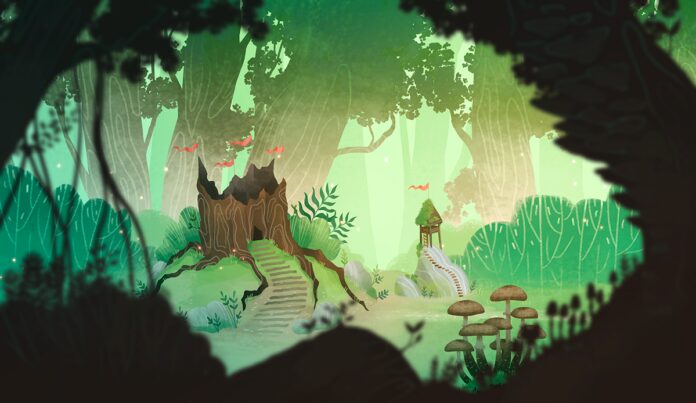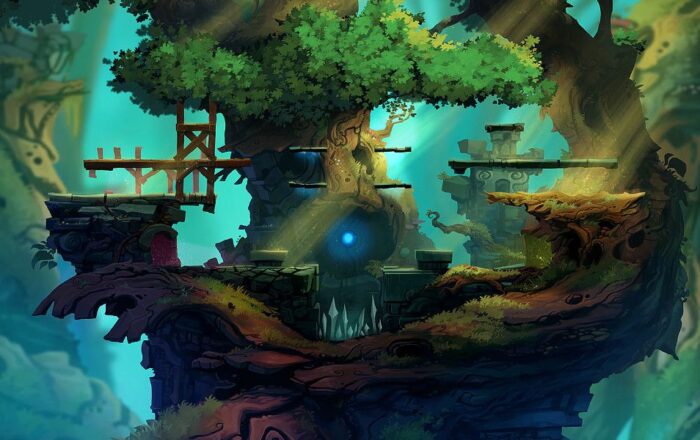
This blog post provides insight into the art and complexities of creating settings in 2D video games. This game development facet, frequently overshadowed by other elements such as gaming mechanics or story, is critical in producing immersive and compelling experiences. The atmosphere of a game sets the tone, influencing mood and guiding player engagement.
Since the spatial dimensions in 2D games are constrained, artistry and innovation in environment design become even more critical. This topic investigates how many styles, ranging from pixel art to vector graphics, contribute to the overall mood of a game, as well as how the limits of 2D can inspire unique artistic solutions.
As we go deeper into this topic, we find the complexities and problems that make 2D scene design a fascinating and essential component of game development, showcasing the unseen effort and artistry that goes into creating intriguing virtual worlds.
The Foundation of 2D Game Environments
2D game environment design is pivotal in establishing the tone and enhancing the player’s immersion in a game. It’s a critical component of game development, where every element in the environment must align with the overarching theme and gameplay mechanics.
A tremendous 2D environment combines beauty and utility. To create this harmony, designers must consider various factors:
- Artistic style that is consistent. A consistent art style sets the visual tone of the game, which should penetrate every part of the environment to sustain immersion.
- Parallax and tilesets. Efficient tilesets save resources, while parallax scrolling adds visual depth and makes the experience more compelling.
- Elements that are interactive. Elements that react to the player’s actions, such as destructible items or moveable barriers, increase the game’s interaction and complexity.
Integration of Narrative

A 2D game’s environment should be a visual narrative that tells its tale through every pixel:
- Themes and symbolism. Visual aspects that correspond to the plot and ideas of the game can give depth and significance to the player’s experience. This includes the use of colors, patterns, and motifs that align with the game’s narrative, enhancing the emotional and psychological impact on the player. For instance, a dystopian game might use stark, contrasting colors to convey a sense of unease, while a fantasy game might employ lush, vibrant hues to create an atmosphere of wonder.
- Storytelling about the environment. Designing places that hint at the game world’s past or mythology may strengthen the narrative without requiring a single syllable of speech. Elements like ancient ruins, overgrown cityscapes, or abandoned structures can tell a story of their own, offering clues about the game world’s history and culture. This approach enriches the gaming experience by allowing players to uncover the lore and backstory as they explore.
Level Design and Player Guidance
Effective level design involves naturally moving the user through the game space:
- Landmarks. Recognizable characteristics in the game world assist players in navigating and can function as crucial advancement stages.
- Flow and pathing. The environment should discreetly lead the player, striking a balance between guiding them and inviting them to explore.
Considerations for Technology
A 2D environment design’s technical execution is equally as vital as its creative aspects:
- Optimization. Efficient design and code guarantee that the game works well across several devices, ensuring a seamless experience.
- Layering. The intentional stacking of items in a 2D area may give the appearance of depth, increasing the visual complexity of the game.
Accepting Aesthetics: Contrast and Color

In a 2D world, aesthetics includes not only the beauty of the images but also its utility and influence on the player’s experience.
- Theoretical color theory. Color can be used strategically to express mood, signal significance, and lead the player’s eye to crucial game features.
- Contrast. Effective contrast may make crucial things stand out and advise or warn the gamer.
Detail vs. Clarity: A Balancing Act
For a compelling 2D environment, the appropriate blend of detailed visuals and gameplay clarity is critical.
- Detailing. Rich details may bring a setting to life, but they should be manageable and manageable for the player.
- Clarity. Players should be able to differentiate between background components and interactive or vital aspects readily.
Animation and Effects in Dynamic Environments
Adding animations and effects may bring a static 2D scene to life, making the experience more immersive and dynamic. Subtle movements, such as the swing of trees or the flicker of distant lights, may lend authenticity and depth to a 2D landscape. Weather changes, time of day transitions, and lighting effects may all dramatically improve the game’s ambiance.
Soundscapes
The soundscape is an important aspect of environment design that should be considered in 2D games. Background noises may provide depth and realism to the game’s visual experience. Audio cues can give feedback or indicate specific actions, improving player connection with the game environment.
Accessibility
Accessibility must be an afterthought in the design of a 2D gaming environment. It is critical to design inclusive games that cater to a varied audience, allowing as many individuals as possible to participate entirely in the game. This method not only broadens the possible player pool but also demonstrates a dedication to the gaming community as a whole.
Design for All

The setting should be constructed with various disabilities in mind so that everyone can play and enjoy the game. Consider color palettes that are distinct to persons with color vision problems, as well as alternate means of conveying information that is traditionally color-dependent.
Controls
Recognizing that players’ physical abilities differ, games should provide for control scheme modification. This might include everything from remapping buttons to enabling different input modalities like touch, speech, or adapted devices built for accessibility.
Compatibility with Assistive Technologies
Games should work with assistive tools such as screen readers and visual aids. By following these guidelines, designers demonstrate that the fun and engagement of gaming are universally accessible experiences.
Conclusion
Designing a 2D gaming world is a difficult endeavor that needs a careful balance of art, technology, story, and music. It’s a blank canvas where every pixel and sound byte matters, resulting in a universe where players can become lost. The secret to success is in the details — color selection, balance, animation, music, and accessibility — all of which work together to produce an amazing gaming experience.
















